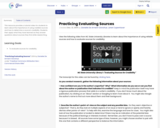
Conditional Remix & Share Permitted
CC BY-NC-SA
This resource provides a tutorial video for students to learn about the importance of using credible sources and how to determine a source's credibility. Students then apply what they have learned as they answer questions about sources they find while researching.
- Subject:
- English
- Research
- Material Type:
- Activity/Lab
- Date Added:
- 11/25/2019
